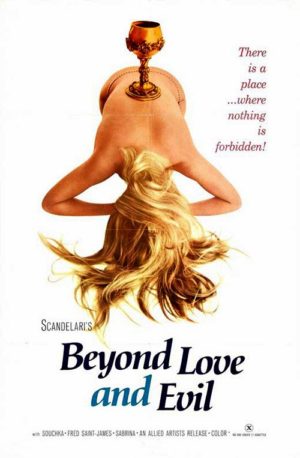 The undoubted magnum opus of French exploiter Jacques Scandelari, this is an undeniably striking, if laughably pretentious, explosion of psychosexual weirdness.
The undoubted magnum opus of French exploiter Jacques Scandelari, this is an undeniably striking, if laughably pretentious, explosion of psychosexual weirdness.
With this film Jacques Scandelari (1943-1999) joined the ranks of Alejandro Jodorowsky, Fernando Arrabal and Walerian Borowczyk. Scandelari made many sleazy films in his day, including MONIQUE (1973) and VICE SQUAD (1978). This 1969 curiosity, released in the U.S. in 1971 as BEYOND LOVE AND EVIL, contained all the sexploitation any sleaze fan could possibly desire, but Scandelari’s aims were weightier than usual. The film’s original title was PHILOSOPHY IN THE BEDROOM (or LA PHILOSOPHIE DANS LE BOUDOIR), and while it’s not a literal adaptation of the Marquis de Sade’s notorious 1795 drama of that title, the spirit of de Sade definitely informs the film.
Late one night a naïve young man named Zenoff enters a heavily guarded country mansion. He finds a vast orgy occurring within, presided over by Yald, a debauched libertine seeking to orchestrate an atmosphere of unbridled sensual pleasure with no concessions to conventional morality. Zenoff is quite shocked, particularly when Yald announces he’s about to be married and that he expects all his guests to have their way with his wife-to-be Xenia—who it just so happens is also Zenoff’s true love!
Following this proclamation everyone retires to bed. The following day Yald releases several guests into a forest where they’re hunted by a pack of dogs. One of the huntees, a young woman, is caught, and as punishment is ravaged by a chained-up savage.
Deciding he’s had enough, Zenoff flees the mansion together with Xenia. They wind up having a tumble in the forest, after which Xenia gets lost. Zenoff finds her back in the mansion, getting married to Yald. This proves to be Yald’s undoing, as Zenoff does him in by stabbing him in the crotch. Zenoff, however, promptly goes mad, and Xenia punishes him for the murder by shackling, branding, whipping and finally abandoning him in the forest.
Even if I weren’t aware of this film’s 1969 copyright date I think I’d have a good idea of the period from which it emerged: the constant dissolves, scraggly post-mod hairstyles, prism-ized visuals and acid rock rendition of “In-A-Gadda-Da-Vida” that’s always being repeated on the soundtrack are all quite redolent of the late 1960s. Another telling element is the lack of any sort of conventional structure, with the frequent and lengthy cutaways to various perversions—a naked conga line, a woman masturbating with an octopus(!), innumerable three and foursomes—given equal footing with the main narrative. Further oddities include snatches of surrealism (as when the protagonist finds himself trapped in a room filled with bizarre paintings) and a lot of philosophical chatter about desire and repression.
Surprisingly enough, the sex, while extremely copious, is never especially graphic (at least in the English language version) and nor is the violence. Audacious and imaginative this film is, but one would expect a bolder and less pretentious treatment.
Vital Statistics
BEYOND LOVE AND EVIL (LA PHILOSOPHIE DANS LE BOUDOIR)
Comptoir Francais du Film Production/Allied Artists Pictures
Director: Jacques Scandelari
Producer: Robert de Nesle
Screenplay: Jean Stuart, Jean-Pierre Deloux, Jacques Scandelari
Cinematography: Jean-Marc Ripert
Editing: Roger Ikhlef
Cast: Souchka, Lucas de Chabaneix, Fred Sait-James, Marc Coutant, Sabry, Serge Halsdorf, Michel Lablais, Milarka Nervi, Doris Thon, Jean-Christophe Bouvet
